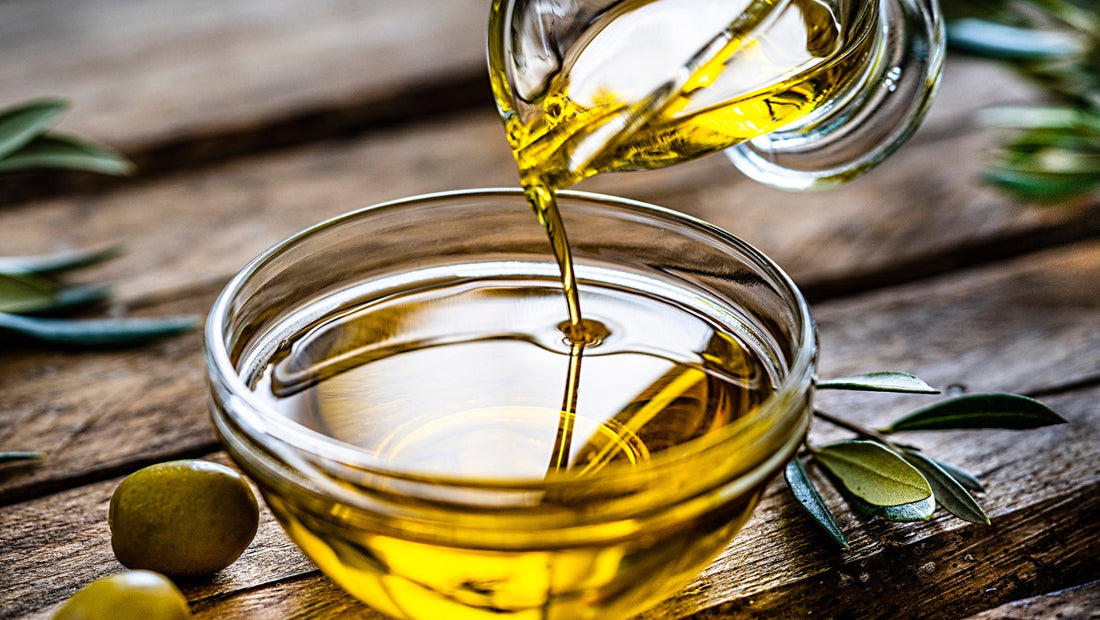
Benefits of Olive Oil for Skin
Share
Olive Oil
Carrier Oil Series
Greetings and salutations, my damies.
This is the second article in our Carrier Oil Series (if you haven't checked out the first one about coconut oil, click here). In this article, we will be covering the benefits, properties and types of olive oil.
As mentioned in the previous article covering coconut oil, a carrier oil is usually a plant-based oil used to dilute essential oils, making them safe to use on the skin.
Olive
Olive oil is obtained by pressing whole olives (fruit of Olea europaea tree) and extracting the oil. The olives are crushed into a paste, then macerated (soaked in a flavorful liquid such as juice, liquor or vinegar to draw out its juices). After, the oil is separated from the water, leaving olive oil.
There are different types of olive oil depending on how the olives were processed. The types we'll be discussing include: Extra virgin olive oil (commonly referred to in the beauty industry as EVOO), virgin olive oil, and refined olive oil.
Extra virgin olive oil: The highest grade of olive oil as it is pressed by mechanical means (using no heat) and unfiltered, so it retains all of the beneficial properties of the olive. This olive oil contains no more than 0.8% free acidity**, and contains natural antioxidants.
Virgin olive oil: Less expensive and slightly lower in quality than EVOO. Can be (almost) as good as EVOO, though the concentration of “the good stuff” is less than EVOO. Virgin olive oil has a free acidity** content of approximately 1.5% (but no more than 2% free acidity).
Refined olive oil: This is usually labeled as “pure olive oil” or just “olive oil”, and is usually refined. It is obtained by processing and refining virgin olive oils using chemicals and high temperatures. This removes many of the health benefits that EVOO offers, including its natural, health-promoting antioxidants. Artificial antioxidants are then put back into the olive oil to increase its shelf-life. Refined olive oil has a free acidity** content of approximately 0.3%.
**During harsher processing, the triglyceride (a trio of fatty acids present in olive oil) links can break, which create “free acidity” or “ free fatty acids” (FFAs). The highest quality types of olive oil have the lowest levels of FFAs.
I will be covering extra virgin olive oil (EVOO), as that is the type of olive oil we use in our products.
Olive oil is rich in monounsaturated fatty acids - these are healthy fats that have various health and cosmetic benefits. Olive oil also contains antioxidants such as Vitamins A, D, E and K, as well as polyphenols, phytosterols, and squalene. Olive oil also contains compounds called triterpenes.
Vitamin A: Readily absorbed when applied topically, it can help improve skin health and assist with certain conditions such as acne by exfoliating the skin, removing dirt, oil and dead skin cells from pores to prevent pimples. With some anti-aging properties, vitamin A can also help improve the appearance of wrinkles and sagging skin by stimulating collagen production, and promoting the formation of new blood vessels. May also protect against sun damage and improve hyperpigmentation (dark spots).
Vitamin D: Helps to create healthy cells, and evens skin tone. Can help treat psoriasis.
Vitamin E: Increases the skin’s capacity to absorb and retain water. It has both anti-aging effects and the ability to provide some protection against damage from UV light penetrating skin layers.
Vitamin K: Helps speed up skin healing. Vitamin K helps the body heal wounds, swelling, bruises, stretch marks, spider veins, dark spots and stubborn circles underneath the eyes.
Polyphenols: Rich in antioxidant and anti-inflammatory properties, helping to manage inflammation and protect the skin from oxidative stress. Applied topically, they can help repair and rejuvenate the skin, and control the aging process.
Phytosterols: Similar to cholesterol in that they benefit the skin by replenishing the lipid barrier while also providing soothing effects.
Triterpenes: Aid in many biological reactions including those necessary for wound healing such as: cell migration, cell proliferation and collagen deposition. They enhance wound repair by reducing the length of time for wound closure.
- Pros:
- Antioxidant protection against environmental damage
- Prevents damage from UV light from penetrating skin layers
- Anti-aging
- Anti-inflammatory and aids in wound repair
- Seals moisture into the skin
- Speeds up wound healing
- Reduces appearance of scars
- Some protection from sun damage
- Can be used as a makeup remover and as an oil cleanser
- Cons:
- Olive oil is rated 2 on the comedogenic scale
- Comedogenic rating of 2: Moderately low risk. It will not clog pores in MOST people
- Sensitive and acne-prone skin should evaluate whether their skin can handle olive oil.
- The oleic acid (fatty acid) component can exacerbate dermatitis and should not be used on infants
- Does not have the antibacterial component like coconut oil does
As you can see, olive oil has some pretty impressive benefits not just for systemic health but for skin health as well.
Note: An easy way to determine if your skin will tolerate olive oil treatment is to do a “patch test”. Apply a few drops to a small patch of skin and observe it. If there are no skin reactions within 1-2 days, it may be safe to experiment on a larger patch of skin.
Thank you for reading.
Which do you prefer: olive oil or coconut oil? Holla at us in the comments!
